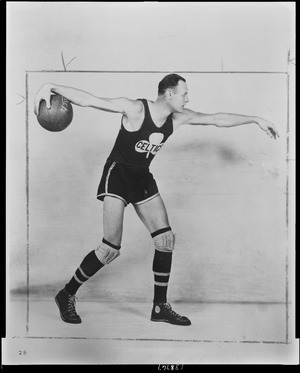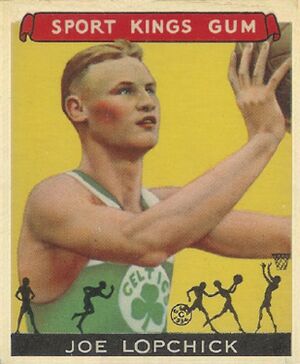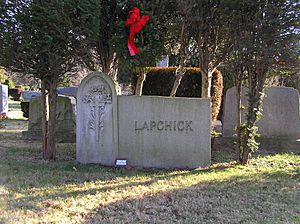Joe Lapchick facts for kids

Joe Lapchick in his first Celtic uniform
|
|
| Biographical details | |
|---|---|
| Born | April 12, 1900 Yonkers, New York |
| Died | August 10, 1970 (aged 70) Monticello, New York |
| Playing career | |
| 1923–1928 | Original Celtics |
| 1928–1931 | Cleveland Rosenblums |
| Coaching career (HC unless noted) | |
| 1936–1947 | St. John's |
| 1947–1956 | New York Knicks |
| 1956–1965 | St. John's |
| Head coaching record | |
| Overall | 334–130 (college) 326–247 (NBA) |
| Accomplishments and honors | |
| Championships | |
As player:
As head coach:
|
|
| Basketball Hall of Fame Inducted in 1966 |
|
Joseph Bohomiel Lapchick (born April 12, 1900 – died August 10, 1970) was a famous American basketball player and coach. He was best known for playing as a center with the Original Celtics in the 1920s and 1930s. Many people thought he was the best center of his time.
After he stopped playing in 1937, Lapchick became the head coach at St. John's University. He coached there until 1947. Then, he became the coach for the New York Knicks in the NBA. Lapchick led the Knicks to the NBA Finals three times in a row from 1951 to 1953. He returned to coach St. John's again from 1957 until 1965.
Contents
Joe Lapchick's Early Life and Career
Joe Lapchick was born in Yonkers, New York. His parents were Czech immigrants. When he was a boy, he helped his family by finding coal near train tracks to help them get by.
Lapchick started playing basketball in his neighborhood at age 12. His mother even made him a uniform! Like many kids back then, he finished school after the eighth grade. By age 15, he was earning money playing for local basketball teams at night. He could make $5 to $10 per game.
When he was 19, he played for four different traveling teams. These included the Holyoke Reds, Brooklyn Visitations, and Troy Trojans. He could earn up to $100 per game, which was a lot of money then. Basketball quickly became his whole life.
Playing for the Original Celtics
In 1923, Lapchick joined the famous Original Celtics team. This team traveled around the Northeast. They amazed crowds with their exciting style of play.
The Celtics joined the American Basketball League (ABL) in 1926. They won two championships in a row. The Celtics were so good that the league asked them to break up in 1928.
Lapchick and two other former Celtics then joined the Cleveland Rosenblums. This team was owned by a department store owner. With Lapchick as their star center, the "Rosenblum Celtics" won two more ABL titles.
The Great Depression caused the ABL to end in 1931. Lapchick then formed a new Celtics team with some other great players. They traveled and played for five years.
Coaching Career and Success
In 1936, Joe Lapchick became the coach at St. John's University in New York City. In 11 seasons, he led the team to a great record of 180 wins and 55 losses. They also won two National Invitation Tournament (NIT) titles in 1943 and 1944.
Coaching the New York Knicks
In 1947, Lapchick turned down a big offer to stay at St. John's. Instead, he took a job coaching the New York Knickerbockers in the new Basketball Association of America (which later became the NBA). Getting Lapchick was a huge boost for the league.
He also signed Nathaniel "Sweetwater" Clifton to the Knicks. Clifton was one of the first African-American players in the league.
Lapchick was known for worrying a lot during games. He lived every second of every game intensely. This stress sometimes caused him health problems, like fainting spells.
Lapchick's Coaching Style
Lapchick was respected for how he motivated his players. He focused on helping them play their best. He liked a fast-paced offense and smooth ball-handling. Lapchick built winning teams at both the college and professional levels.
As a player, Lapchick was a great passer and shooter. This made him one of the first great professional centers. His skills helped his teams win many championships.
He led the Knicks to eight winning seasons in a row. They also made it to the playoffs eight times. This included three straight trips to the NBA Finals from 1951 to 1953. The Knicks team in 1953–54 was very talented. Eight of those players later became coaches themselves, showing Lapchick's great leadership.
Lapchick was a very active coach on the sidelines. He would stomp his coat, break chairs, and throw things in the air when he was stressed. Health problems forced him to stop coaching the Knicks in 1956. He left the Knicks with a coaching record of 326 wins and 247 losses.
Return to St. John's
After leaving the Knicks, Lapchick rested for only a month. Then, he went back to coach at St. John's. In nine more seasons, he led the team to two more NIT championships. This gave St. John's a record four NIT titles under his coaching.
Lapchick cared about his players' schoolwork, not just their basketball skills. He was a two-time college Coach of the Year. He had to retire after the 1964–65 season at age 65 because of school rules. He had several heart attacks that year. His final season ended with St. John's winning the NIT Championship Game against Villanova.
Lapchick later wrote a book called 50 Years of Basketball in 1968. It shared stories from his early playing days and explained his coaching ideas. He also continued to be a spokesperson for the sport.
Joe Lapchick died from a heart attack in Monticello, New York, in 1970. He was 70 years old.
Legacy and Honors
- Lapchick was chosen for the Naismith Memorial Basketball Hall of Fame twice. First, as a member of the Original Celtics team in 1959. Then, as an individual in 1966.
- To honor him, St. John's University created an annual college basketball tournament called the Lapchick Memorial Tournament.
Lapchick's Family
Joe Lapchick married Elizabeth Sarubbi in 1931. They had one daughter and two sons.
- Their daughter, Barbara Lapchick, was one of the first models for Ford.
- Their son, Dr. Richard Lapchick, is a human rights activist. He is an expert on sports issues and an author. He works for racial equality and helps young people learn about improving race relations.
- Their son, Joseph Lapchick, earned a PhD from Harvard. He worked as a superintendent of schools in Aspen, Colorado, and later in Philadelphia.
See also
 In Spanish: Joe Lapchick para niños
In Spanish: Joe Lapchick para niños



